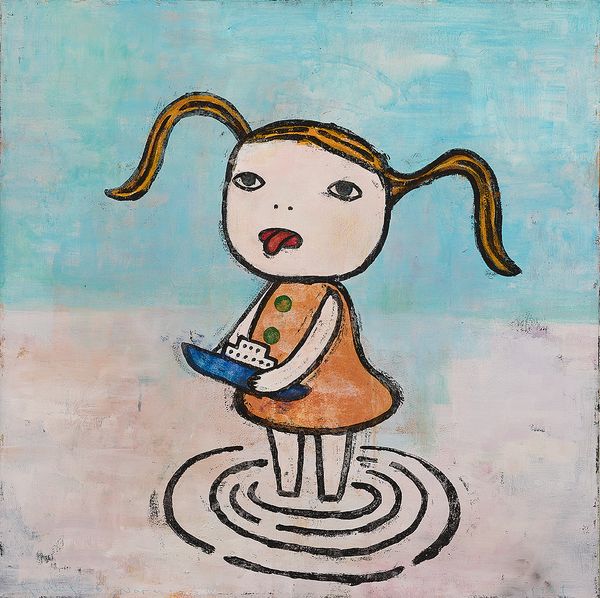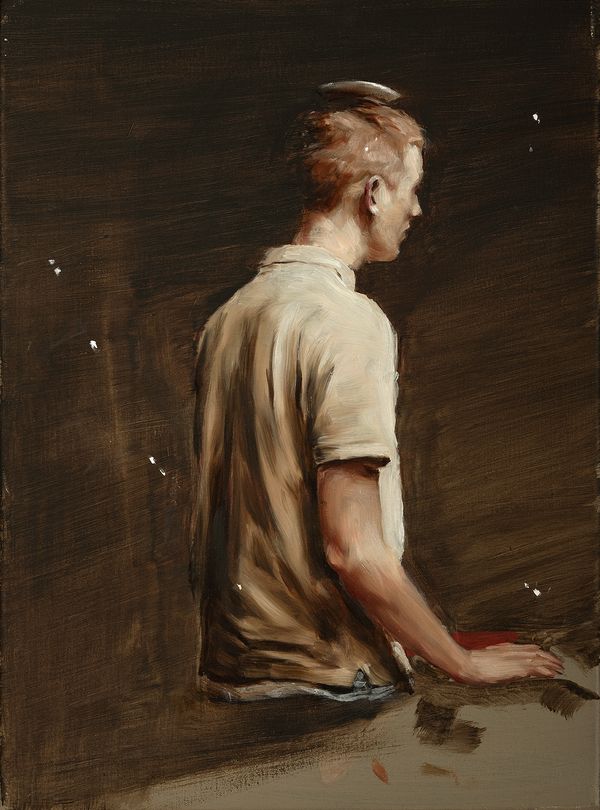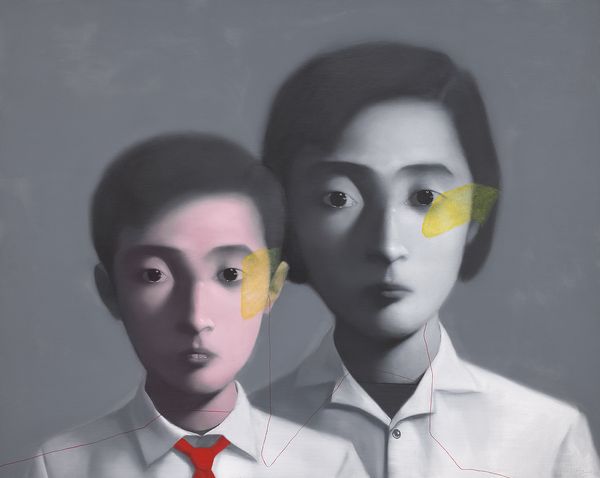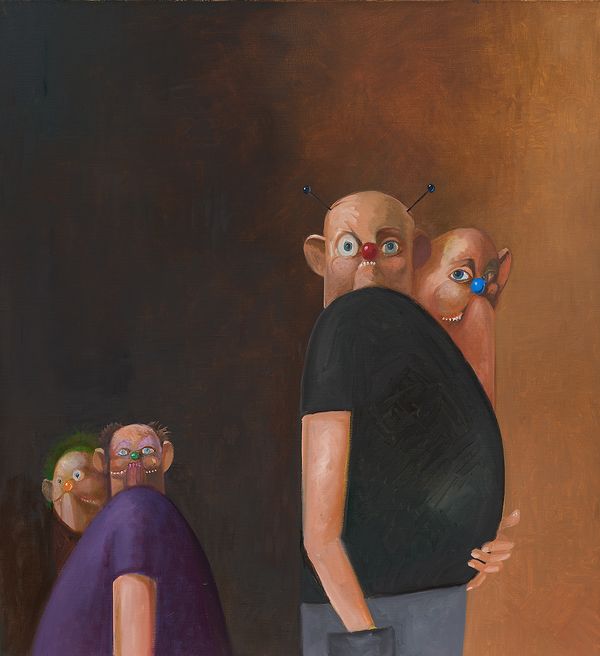(Left):Yoshitomo Nara ,Untitled,1991. (Right):Zhang Xiaogang,Bloodline Series - Big Family, 2006.
In Yoshitomo Nara's paintings, the little girl always stands alone, similar to the mysterious, single figure depicted by Belgian artist Michael Borremans—both are immersed in a world of alienation and isolation.
The figures depicted in the Bloodline series created by Chinese contemporary master Zhang Xiaogang’s Bloodline series and George Condo’s portraits are no longer alone, representing unique approaches and visual languages adopted to interpret the concept of “family portraits” — yet they still retain an air of eerie disconnection nonetheless. In all of these pieces, the dynamics of loneliness and togetherness are explored as part of the evening sale of Phillips’ 20th Century & Contemporary Art & Design Hong Kong Auctions, unravelling what it really means to be a part of — and apart from — companionship and society.
Yoshitomo Nara , Untitled, 1991
Estimate HK$6,000,000 - 8,000,000
Lot 20, 20th Century & Contemporary Art Evening Sale
Yoshitomo Nara
A pioneering figure in the contemporary art world, Japanese artist Yoshitomo Nara’s works showcase inner emotion, conveying sensitivity and fragility. Growing up in the small, agricultural town of Aomori in Northern Japan, Nara’s childhood was spent surrounded by nature, with trees and animals as his only companions. In 1988, after graduating from the Aichi University of the Arts, Nara moved to Germany to study at the Kunstakademie in Düsseldorf. When asked to reflect upon his time spent in the foreign city, Nara recalls how he became “alone” there, which reminded him vividly of his lonely childhood.
Painted in 1991, Untitled is a celebration of child-like imagination, which appears to be kawaii (cute) at first glance, yet a closer look reveals a sense of quietude and contemplation, representative of the artist’s time living in Germany as a foreign student and artist. Featuring characteristically flat colours, bold black outlines, and an absence of traditional perspective, Untitled crystallises the psychological state of isolation and nostalgia. A lone girl stands upon a puddle within an empty void, reflecting emotions of estrangement felt by the artist in a foreign land that is universally relatable.
Michaël Borremans
Michaël Borremans ,Stars, 2008.
Estimate: HK$ 2,000,000 - 3,000,000
Lot 23, 20th Century & Contemporary Art Evening Sale
Compared to Nara’s colourful, childlike depiction, Belgian artist Michaël Borremans adopts a completely different approach in terms of a lone world. He is recognised for his moody paintings that are charged with psychological suspense, whilst portraying dark and uncanny narratives with an irresistible appeal. Borremans ’ portraits depict his protagonists in his signature sepia hues, steeped in ambiguous, alluring symbolism.
Borremans situates an enigmatic young man with his back against the viewer at the centre of Stars, standing within a dark, peculiar void hiding unknown depths. Finding himself in a pensive state, the intensity of the figure’s focus cuts through the painting’s surface even though the view of his eyes is hidden from the audience.
With a background in draught making, printmaking, and photography, Borremans’ reference to photography is evident in his current work which is saturated with theatrical elements and psychological suspense. Scanning Stars further down, one would be shocked to discover the human portrayal abruptly ends at the upper torso — what was considered to be the partial depiction of the figure turns out to be a disturbing image of an incomplete body. This incompleteness declares the work as a glimpse into an alternative reality bearing an uncanny similarity to the one we live in. The suspense is disquieting and compelling simultaneously, working as a disruptor to reset the viewer’s lens of reading into this painting.
Zhang Xiaogang
Zhang Xiaogang, Bloodline Series - Big Family,2006
Estimate : HK$7,500,000 - 10,000,000
Lot 25, 20th Century & Contemporary Art Evening Sale
Contrary to Nara's loneliness and Borremans’ dark, psychological suspense,Zhang Xiaogang's Bloodline series integrates inheritance and collective history into his creations, establishing connections between people who are biologically unrelated.
Triggered by the discovery of his own family photos, Zhang started his Bloodline series inspired by the personal history and associated emotions they encapsulate. He wanted to make connections between people who were unrelated as well: “They might be relatives, friends or unrelated. I wanted to string them together like a network to create the feeling of a family.”
In Bloodline Series - Big Family, Zhang brings together ideas of personal heritage, collective history and cultural inheritance, crystallising snippets of the past onto the canvas, creating works that reflect on the social undertones of a bygone era that is able to resonate with the viewer emotionally and psychologically. Beginning in 1993, the Bloodline series marked the year in which the artist abandoned Expressionism, moving away from Surrealism and personal existentialist meditations and towards investigations on national and collective history.
George Condo
George Condo, The Stangers,2009.
Estimate: HK$5,000,000 - 6,500,000
Lot 17, 20th Century & Contemporary Art Evening Sale
Ironically titled The Stangers , the current work depicts the artist, his wife, and their two daughters. Executed in 2009, The Stangers is emblematic of his outlandish, whimsical style, and was featured in a solo exhibition, Family Portraits, with Sprüth Magers, Berlin in 2010.
Reflecting the title of the exhibition, the present lot depicts the artist’s family — though they are barely identifiable, having been mutated beyond recognition. This family portrait is an undeniably unorthodox one; reimagining the realist genre with a bizarre, surreal twist. The Stangers demonstrates Condo's virtuosity in absorbing the genius of the great masters before him, and his success in ventriloquising and reworking historical painting styles, translating them into his own pictorial vocabulary.
Recommended Reading
Their Asia Debut: 5 Artists to Watch in the Hong Kong Sales >




